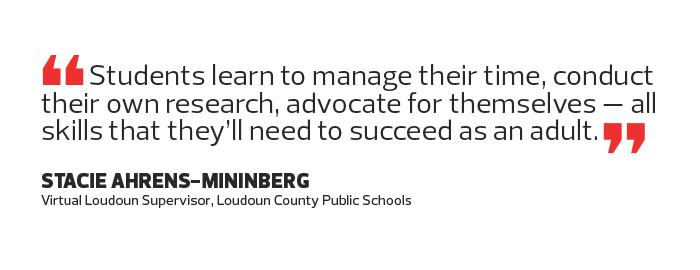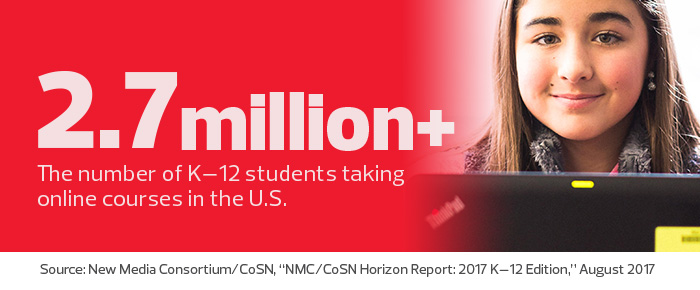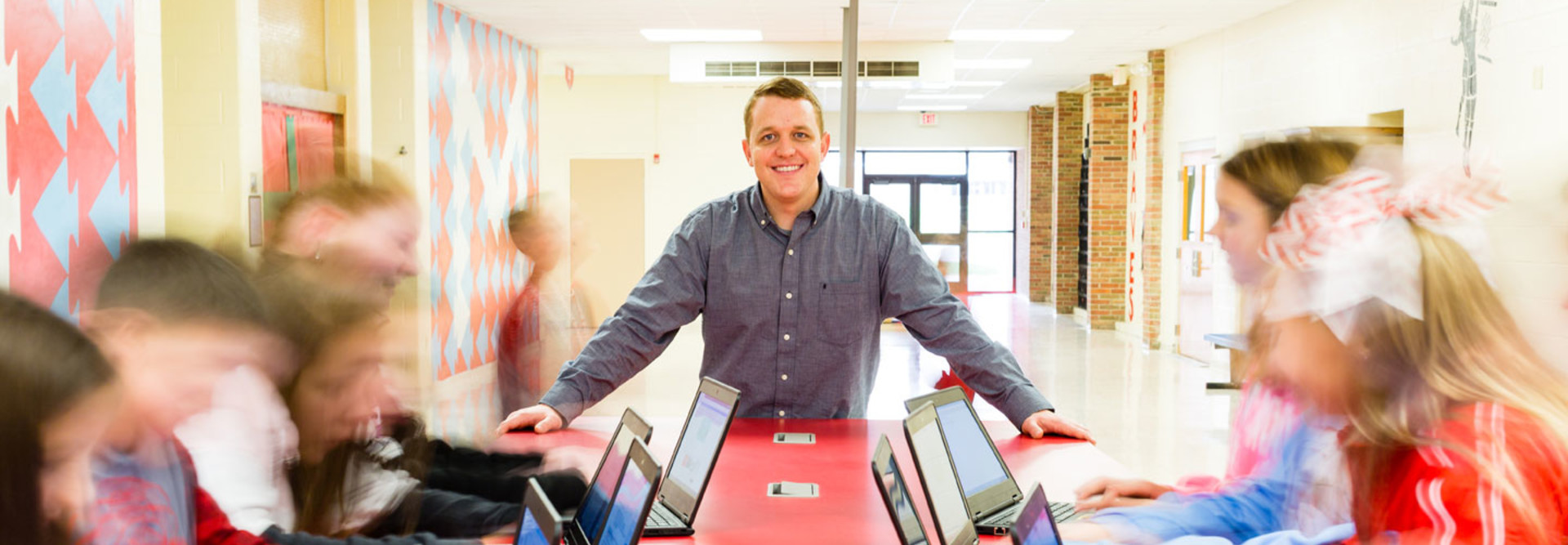Online Learning Keeps Schools Open All of the Time
There are many reasons why students can’t make it to school as planned: snow days, a local disaster, a flu outbreak or professional development days for teachers. But does that mean that all teaching and learning should come to a screeching halt?
Officials at Maconaquah School Corp. in Bunker Hill, Ind., don’t think so, especially after they experienced a harsher than average winter that kept their 2,200 students out of school for 14 snow days, throwing academic calendars and everyone’s spring break and summer plans into disarray.
MSC had already deployed a one-to-one initiative, so in 2014, they applied for a grant from the Indiana Department of Education to run a pilot program for flexible scheduling.
“If students are fully connected to their teacher, their peers and all the resources they need, then learning should be able to take place anytime, anywhere,” says Chris Percival, technology director at MSC. “If you can do that, then you should be able to provide a full instructional day even when students are not at school.”
Online Learning Brings Continuity of Education
MSC officials worked out a plan to hold four “eLearning Days” that first year. On these official school days, students would stay home but still “attend” their regular academic classes and complete their assignments online using their Chromebooks or tablets.
Students were already using Lenovo ThinkPads throughout the school day to access Google’s G Suite applications, including Google Docs and Google Drive, while teachers were using Google Classroom to connect with students and make assignments.
All the district had to do was move that same learning model and toolset to the home environment. One advantage: Although the district is largely situated among cornfields, all MSC students had adequate internet access, thanks to a local service provider and school supporter that had enabled line-of-sight broadband across the entire district. Still, the plan wasn’t without its challenges.
On the first eLearning Day, the IT team contended with the typical operational problems of devices, passwords and internet routers. The biggest issue, though, came when a hiccup in the software filter outfitted on all school-owned devices started blocking students from accessing any websites.
“It was pretty ugly,” Percival admits. “We had to either remote our way into their device or give them our administrator password and walk them through the steps to uninstall that software so they could get out onto the web and get their lessons done.”
The team quickly made adjustments, and subsequent eLearning Days went smoothly. In fact, district staff and students got so comfortable with the setup that they began using it for other school breaks, both scheduled and unscheduled.
MSC now uses the eLearning setup for snow days and professional development, and to allow students who are sick or injured to keep up with their classmates while they’re away from school.

And more recently, high school students have started taking online courses from outside providers to bolster their high school record or gain college credits.
Teacher Kari Catanzaro says that although there are many benefits that come with the district’s embrace of the eLearning program, the greatest is continuity.
“Missing just one day can be so disruptive to the learning process,” she says, noting that assigning a one-day skills review, a subject matter video or a recorded lecture helps keep students on track. “So when we have snow days or a student is out for whatever reason, they do their assignments at home.”
Virtual Learning Experiences Expand
MSC officials may have been ahead of the curve with eLearning Days, but they’re gaining company. The number of K–12 students participating in at least one virtual learning experience during the school year has grown exponentially over the past decade, says Bruce Friend, COO for the International Association for K–12 Online Learning. “It’s hard to even put a clear number on it,” he says. “The numbers are in the millions.”
That’s because the options for students to participate in online learning are so broad. Some schools leverage online learning to keep students abreast of their studies during periods of suspension or a long-term illness. Some offer online courses to give students access to teachers or subjects the district is unable to provide. In other cases, students use online courses to give them the flexibility they need to make their academic and athletic schedules work.
“Online learning has helped redefine how one can receive an education, where they can get it and the time at which they can access it,” Friend says. “It no longer needs to be limited to what’s available to you based on the ZIP code you happen to live in.”
Online Programs Increase Course Offerings
For many schools, the easiest way to try virtual learning is by offering supplemental online courses to students with unique interests and academic needs. That’s what inspired Pascack Valley Regional High School District in Montvale, N.J., to purchase seats from Virtual High School, a third-party online coursework provider, so that students could take an extra or alternative course. Getting started with VHS courses was easy because the district, which has two high schools, has long had a one-to-one laptop program.
“Within a few years of our laptop initiative, we had students who wanted to take courses that we didn’t offer, including one who was interested in AP Japanese,” says Barry Bachenheimer, Pascack Valley’s director of curriculum instruction and assessment. “Finding a teacher who specialized in Japanese and trying to fill a class with students interested in that niche was prohibitive from both a cost and a logistical standpoint. It made more sense to use something that was already available.”
One challenge is finding money for the online coursework, which “doesn’t come cheap,” Bachenheimer admits.
Fortunately, the district’s school board recognizes the benefits and has been supportive, and the district is able to partially offset the cost by having two of its own teachers provide instruction to other VHS enrollees.

The number of Pascack Valley students who enroll in virtual courses has varied year to year, from as few as 40 to more than 200. The courses — either live or self-paced — cover a diverse array of subjects, from advanced calculus to art history.
eLearning Offers Up Options and Flexibility
Loudoun County Public Schools in Ashburn, Va., has turned to its supplemental online program, known as Virtual Loudoun, to cope with not only the unique academic wants of students but also the logistical and budgetary issues that come with being one of the fastest growing districts in the country. LCPS currently has 81,000 students, nearly double the number it had a decade ago.
The district’s Virtual Loudoun team, made up of a supervisor, counselor and an instructional designer, used the program’s initial budget in 2014 to purchase prefab courses that aligned with Virginia standards, along with loaner Dell laptops and Kajeet SmartSpot devices for use by those students who lacked the necessary computing and internet resources at home.
Participants typically include students who enroll after school has started or who need flexibility to make their schedules work, those who want to take advanced courses, and elite athletes and others whose activities prohibit them from regularly attending their brick-and-mortar classes.
Enrollment has doubled with each year, says Stacie Ahrens-Mininberg, Virtual Loudoun’s supervisor. This fall, more than 650 students signed up for at least one course, and Ahrens-Mininberg expects another 2,400 or so will enroll in the spring and summer terms.
The program offers numerous benefits, Ahrens-Mininberg says.
“Students learn to manage their time, conduct their own research, advocate for themselves — all skills that they’ll need to succeed as an adult,” she says.








